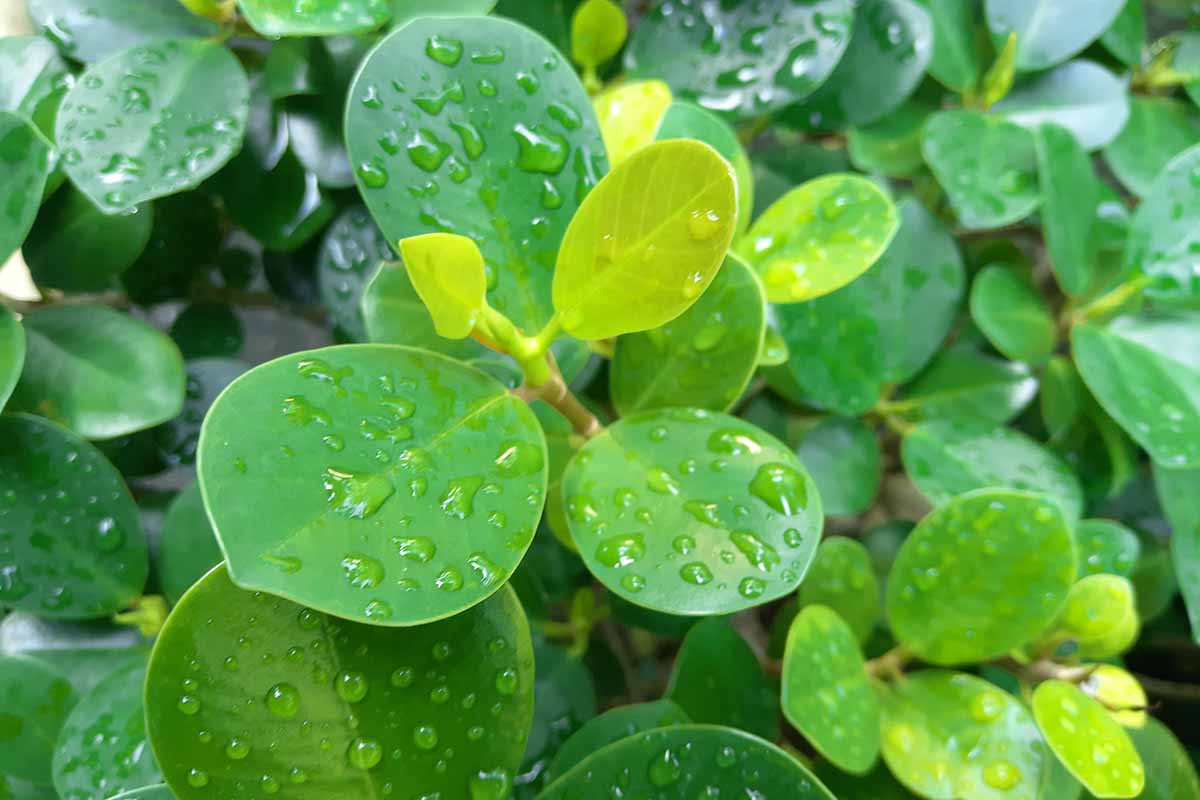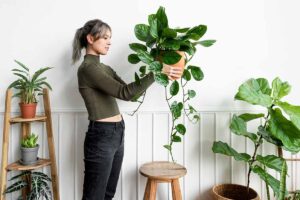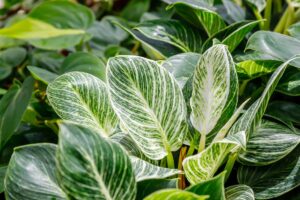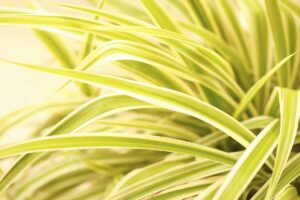Ficus microcarpa
Ginseng figs (Ficus microcarpa) are popular houseplants that you most commonly see for sale potted up as quick-growing bonsai.
They’re also known as curtain figs, Indian laurel, Chinese or Malayan banyan, or just banyan trees, though true banyan trees are actually F. benghalensis.
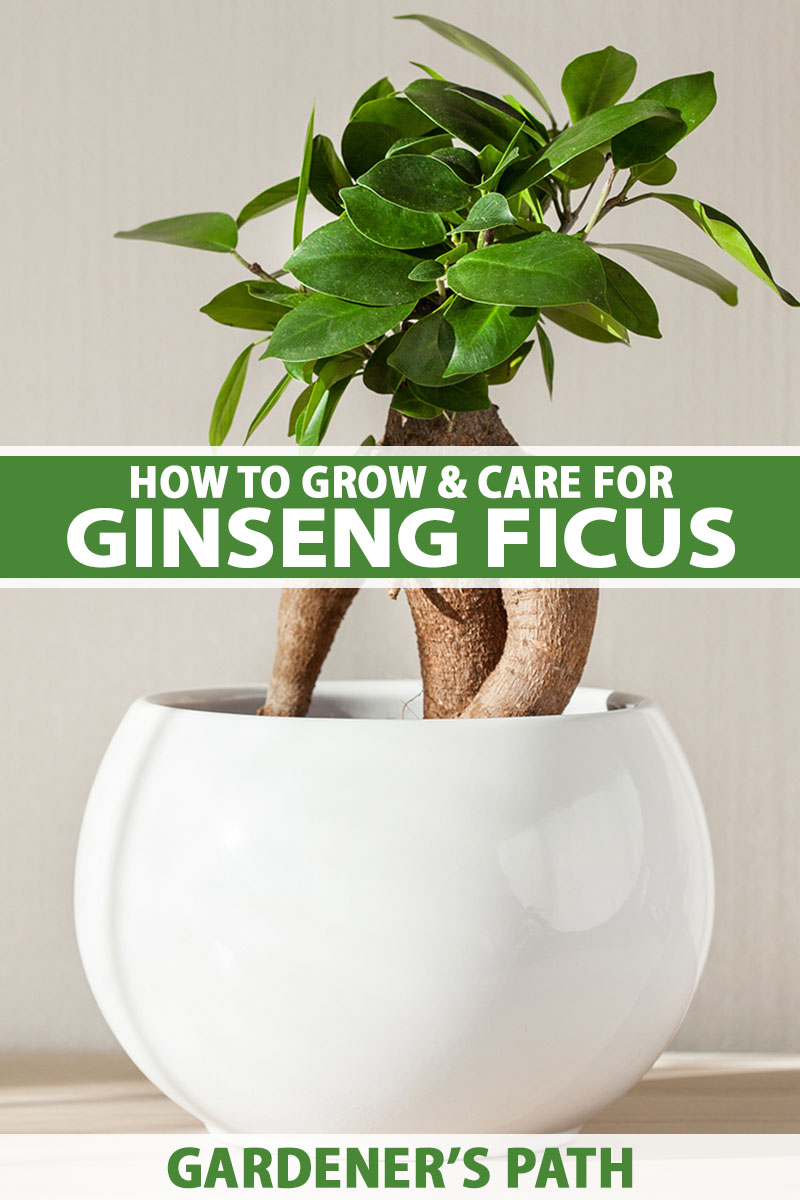
We link to vendors to help you find relevant products. If you buy from one of our links, we may earn a commission.
The first time I ever saw a ginseng fig was a tiny bonsai with multiple twisted trunks with different widths. I thought it was charming.
The next time I saw one, it was a behemoth in Hawaii. I never put the two together until I was considering my next bonsai project and came across some information about these trees.
You could say that the ginseng ficus has many faces.
F. microcarpa can be a mild-mannered houseplant or a massive tree that can spread hundreds of feet. But these plants aren’t troubled by being constrained and kept indoors.
They do just as well in your home or office as they do in their tropical homes.
Coming up, here is what we’re going to talk about to help yours thrive:
What You’ll Learn
Trees in the Ficus genus are some of the most popular houseplants.
Both fiddle-leaf figs (F. lyrata) and rubber trees (F. elastica) are ficuses.
Cultivation and History
Ginseng figs are native to southeast Asia, Australia, India, Japan, Nepal, and the Himalayan region.
They have been introduced to California, Florida, Hawaii, Spain, South America, and the Caribbean.
These plants typically start out as epiphytes, growing on other plants to access light and nutrients.
As they mature, they send down aerial roots that allow them to anchor and transition to life as a terrestrial tree. Plants that have this type of growth pattern are known as hemiepiphytes.
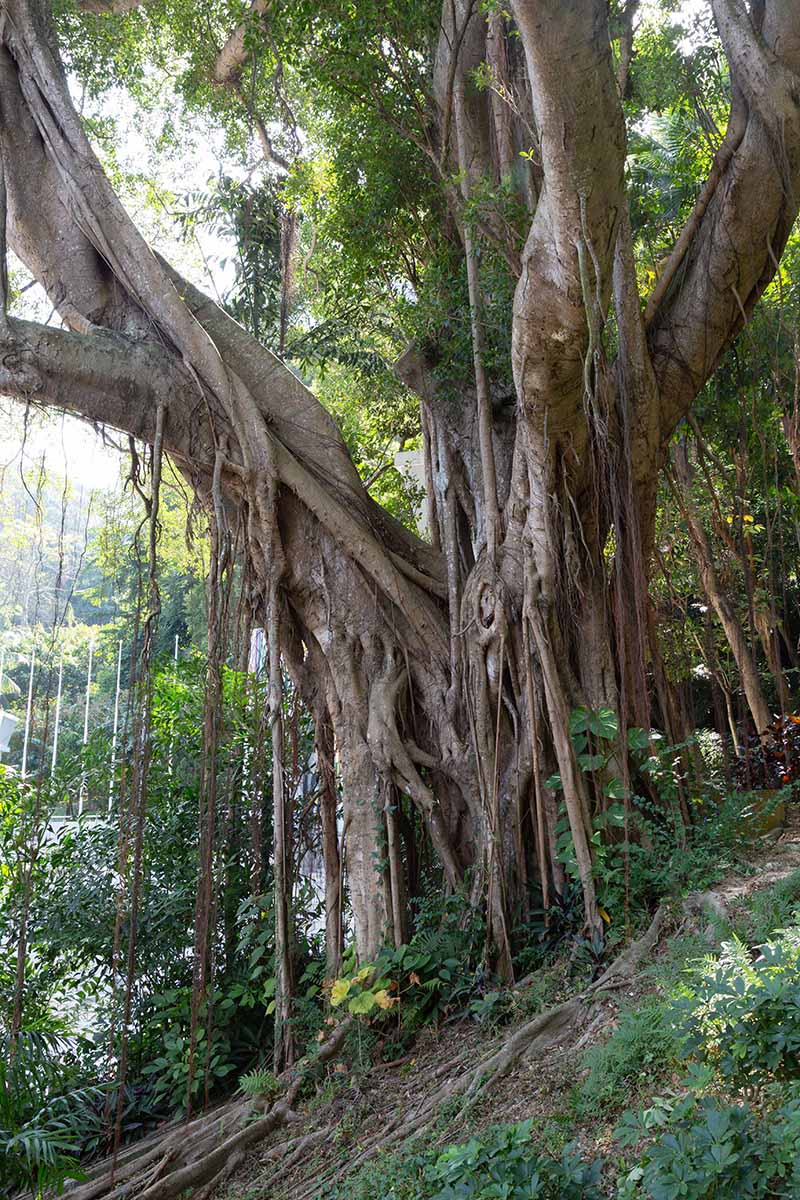
Laurel figs grow about 50 feet tall outdoors and typically have a rounded crown.
The trees have smooth, gray bark and alternate small leaves that are oval-elliptic in shape. In the wild, all of the foliage is green, but there are a few variegated cultivars with cream, yellow, or white patches.
The tree doesn’t form what we think of as traditional flowers. The flowers are actually hidden inside the fig fruit, just like the edible fig (F. carica), to which they are related.
To call figs fruits is technically incorrect. They aren’t fruits at all but an inverted (inside out) inflorescence. A wasp crawls inside this “fruit” to pollinate the flower.
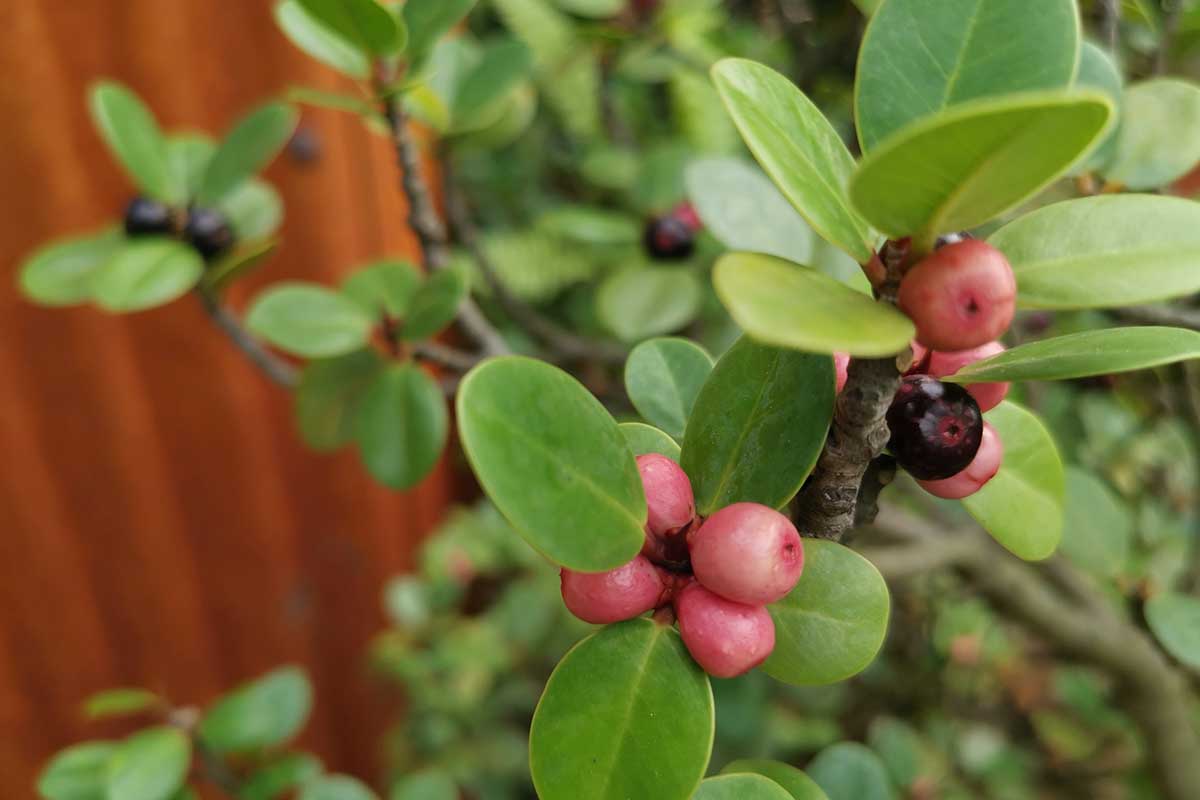
When mature, the fruit turns from green to red and while they are technically edible, they are not palatable.
If you’re growing your plant indoors, you won’t see fruits since the trees are unlikely to receive enough light.
The trees develop long, dangling aerial roots that can resemble numerous trunks, adding to their fascinating appearance.
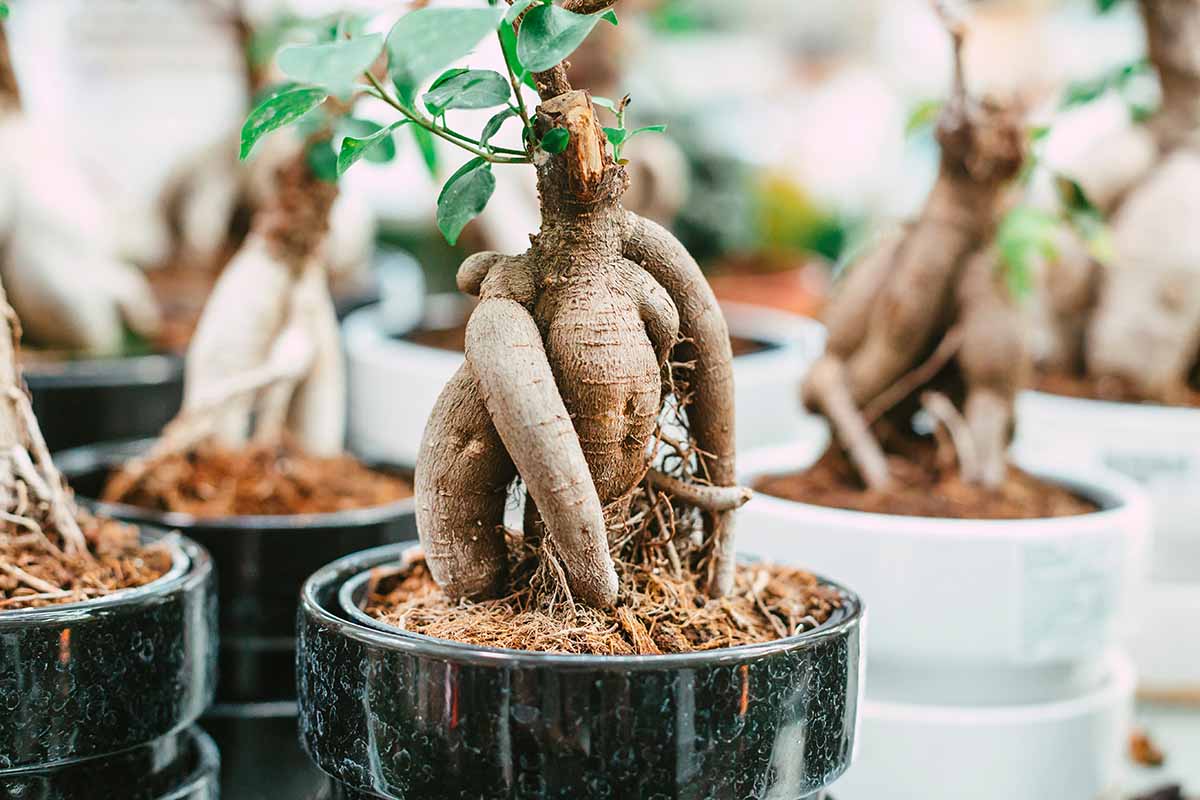
Though 50 feet is the average, these trees can grow much larger outdoors. If you’ve ever visited Hawaii, you might have seen the 110 foot tall, 250 foot wide banyan at the Menehune Botanical Gardens.
Though not native to the islands, it’s the largest F. microcarpa tree known to exist. It’s lovingly nurtured by garden caretakers and admired by visitors from around the world.
Then there are places such as Florida, where the tree has escaped cultivation and become a nuisance to the point where it has been listed as invasive.
It’s worth noting that the tree couldn’t have escaped and spread as far and wide in Florida if not for the accidental introduction of the one wasp species that pollinates F. microcarpa.
Eupristina verticillata was likely introduced to Florida after hitching a ride on imported plants and the rest, as they say, is history.
Indoors, they are much more polite, rarely growing more than six or seven feet tall and about half as wide.
Ginseng Fig Propagation
One tree, oh so many ways to propagate it. Some plants seem to want to fight you when you try to reproduce them and some seem to be going out of their way to help you.
F. microcarpa is the latter. It’s one of those plants that might propagate itself while you aren’t looking.
Air layering, cuttings, and purchasing nursery starts are viable options. Let’s cover air layering first.
Air Layering
These plants, from the smallest bonsai to the largest tree, take well to air layering. Bonsai artists often use air layering to refine the shape of a plant but you can also use this technique to create a clone of the parent.
Start the process anytime of year except winter. Gather up a scalpel or sharp knife and clean it really well with soapy water. Then, wipe it with isopropyl alcohol. The last thing you want to do is to spread disease from a dirty tool.
Select a branch that has the diameter of a pencil, or slightly larger.
Pull off any leaves from the area where you want to work. You need about four to six inches of exposed wood.
Use your knife to gently peel away the bark, exposing the tan layer underneath. You only want to remove the bark, not cut deep into the plant tissue. It can make things easier if you make a cut all around the circumference and then make another all the way around an inch below. Then, make a vertical cut connecting the top cut to the bottom one.
Then, gently insert the knife or scalpel into the slit you made and pull it up. Peel the rest of the bark off from this section.
Wrap the cut in moistened sphagnum moss. You want the cut to be covered by an inch of overlap on either side and about an inch of moss around the circumference. Then wrap clear plastic around that. Secure the top and bottom of the plastic package with rubber bands, string, or twine.
Keep the plant in a spot with bright, indirect light and ensure the moss stays moist but not soggy. You’ll need to open the plastic and check the moss occasionally. If it’s dry, water it using a spray bottle.
When you can see roots have formed inside the moss, remove the plastic. Cut off the branch just below where the roots are developing. Plant this in a separate four- or five-inch container.
From Cuttings
If you want an easy plant to propagate via cuttings, you’ve found it. This process should be done in the late winter, spring, summer, or early fall, for the highest chance of success, but it will work anytime of year.
Look for a branch that is long enough for you to take a four- to six-inch cutting. The diameter doesn’t matter. If the branch has aerial roots or a root node, all the better, but this isn’t required.
Remove all but the top two leaves and gently insert the cutting into a four-inch container filled with potting mix. Alternatively, you can place the cutting into a clean glass of water. Either way, about a quarter of the cutting should be submerged in the soil or water.
Place your cutting in an area with bright, indirect light as it develops roots.
If you’re rooting in soil, keep the medium moist, and for cuttings in water, change the water daily.
If you started the cutting in water, it will be easy to see the roots developing. Once they’re a few inches long, you can pot up the cutting.
For a cutting started in soil, you’ll want to wait until new leaves start to develop before you put your plant in a permanent spot or container. You can transplant it at this point or leave it in place until the roots outgrow the container.
We’ll talk about planting a potted ginseng ficus next.
Transplanting
This is the route that most people choose because these plants can be had for a song at many retailers.

Once you bring your new baby home, find a pot about the same size as the existing container or one size up.
Remove the plant from its pot and gently loosen up the roots. Hold it in place in the new container at the same level it was before and fill in around the roots with a water retentive, loose potting mix.
If needed, you can put a small layer of soil in the bottom first. Moisten the soil and add a little more if it settles.
How to Grow Ginseng Ficus
As a houseplant, it would be a big challenge to find something easier to grow and care for than ginseng ficus.
Most Chinese banyans that you’ll pick up at the store are used to bright, indirect light, and that’s perfectly fine. But they can grow in direct sun, as well. As large trees outdoors, they grow in full sun all the time.
If you want to increase the amount of light your plant receives, do it gradually over a week, adding a little bit of time in the sun each day.
Ideally, give the plant at least a few hours of direct light in the morning and then bright, indirect light for the rest of the day.
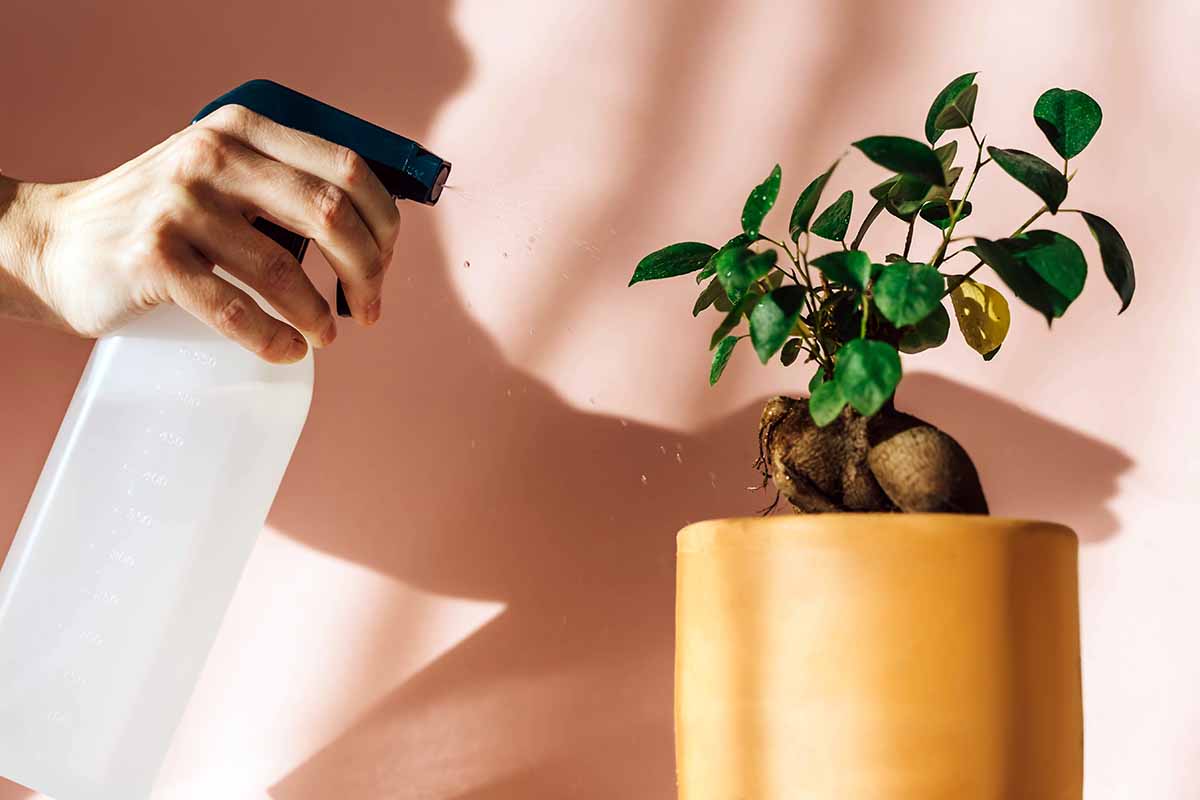
Although they can tolerate brief drought, keep the soil moist but not wet. The top inch can dry out with no trouble, but try not to allow it to get any drier than that.
These plants drop their leaves pretty readily, so don’t be shocked if one or two fall now and then as the light or temperature changes over the course of the year.
Any more than that and you’ll want to visit our guide to falling ficus leaves, which will help you determine why the leaves are dropping and how to fix it.
Don’t expose the plant to temperatures below 50°F. That means avoiding spots near windows or doors that might be drafty in the winter. Temperatures between 60 and 85°F are ideal.
As a natural hemiepiphyte, this plant does best in a loose, airy potting mix. You can find soils intended for tropical plants or aroids. I just make my own by mixing a standard potting mix with an equal part of orchid bark.
When choosing a container to hold all this soil, the material isn’t important. Unglazed earthenware tends to dry out quickly, which is useful if you have a tendency to overwater. If you tend to underwater, metal, plastic, or glazed earthenware is probably a better choice.
Regardless of the type of pot you choose, it must have drainage holes to allow the water to drain out.
Ginseng figs won’t tolerate wet roots. If you use a catchment tray or saucer, or decorative exterior pot, be sure to empty it 30 minutes after watering.
These plants aren’t too fussed about humidity levels, though if you want lots of aerial root development and to avoid brown leaf tips, try to keep them above 55 percent relative humidity.
Growing Tips
- Provide some direct light, but expose to bright, direct light gradually
- Allow the top inch of the medium to dry between watering
- Keep the plant in temperatures above 50°F
Pruning and Maintenance
In terms of maintenance, this plant doesn’t demand much. Wipe the leaves down regularly with a wet cloth to remove dust.
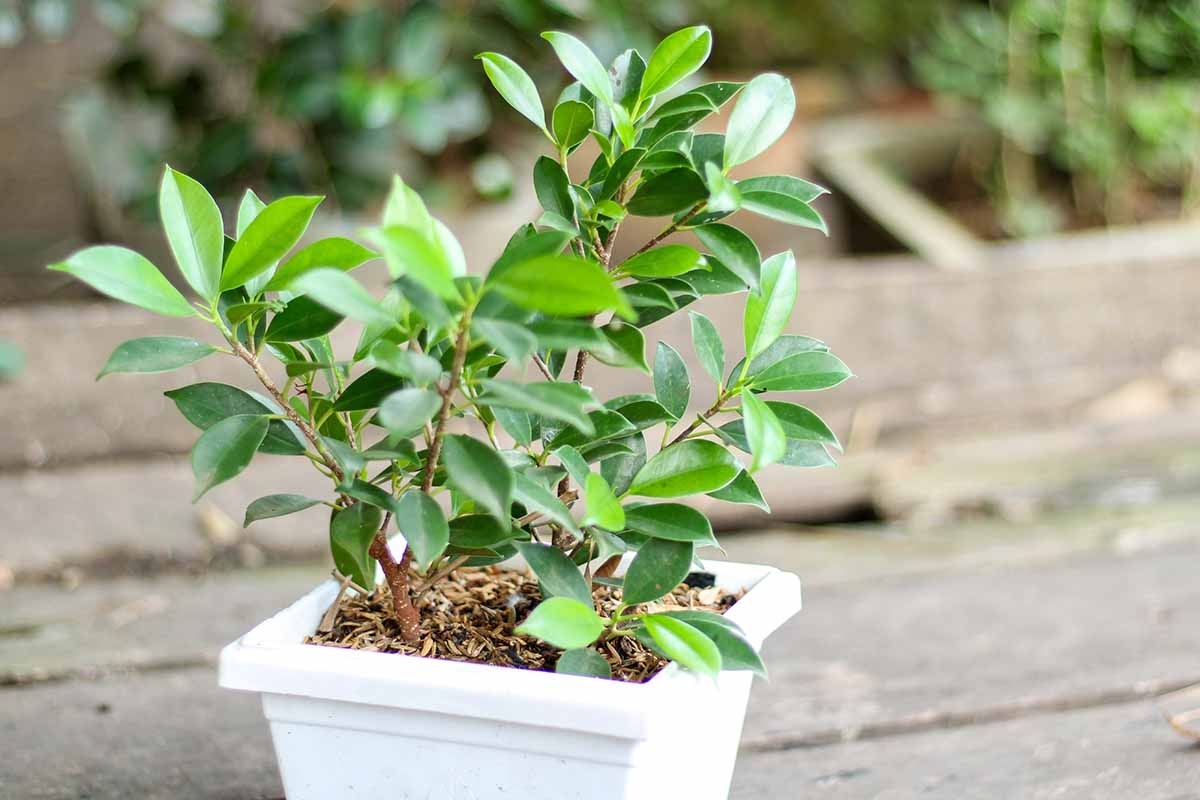
It’s not necessary to prune this plant unless you want to give it some shape or to remove anything that fits the four Ds: Any branch that is deformed, damaged, dead, or diseased should be snipped off.
If you want to prune for shape, wait until the spring and cut away. These plants can tolerate quite a bit of pruning, so go to town. Just don’t prune more than half to a third of the plant at once.
When pruning, use a clean pair of clippers or scissors. Before you start cutting, wash the tool in soapy water and then wipe it with isopropyl alcohol.
Cut the branch, stem, or leaf off as close to the stem or trunk as you can, you want to avoid leaving behind a stump. If you shorten a branch to encourage bushier growth, cut just above of a leaf node.
During the spring, summer, and early fall, feed the plant once a month with a mild, balanced fertilizer.
I prefer something like Dr. Earth’s Pump & Grow, which has a 1-1-1 NPK, so it’s perfectly balanced for frequent houseplant feeding.
It also comes in a handy pump container, which makes it easy to use.
You can pick up a 16 ounce pump bottle at Arbico Organics.
As the plant matures, you’ll need to upgrade the container size. It’s also necessary to replenish the soil because soil becomes compacted and hydrophobic over time.
You can replenish the soil every two to three years regardless of whether or not you change the container.
Ficus species generally don’t mind being a bit rootbound, but don’t let them become too crowded or the plant will stop growing and may become more susceptible to pests and disease.
Figuring out the timing of when to repot can be a bit of a challenge because you don’t want to move a plant before it’s ready. Putting a plant in a container that is too large will make the soil prone to retaining too much water, which can lead to root rot.
You can be confident it’s time to repot if you see roots coming out of the drainage holes in the bottom. Otherwise, stick your finger into the soil.
If there’s enough room to stick your finger in without hitting roots everywhere you try, it’s fine. But if you can’t find a spot to stick your finger in, it’s time to upgrade.
Don’t go up more than a single size from the existing pot.
To repot, remove the plant from the existing container and brush away all of the existing soil. Then, place it in the new container filled with fresh potting soil.
In the summer months, you can bring your plant outdoors, but if you expose it to brighter light, be sure to do so gradually over a week or two by starting with just a half hour a day.
Ginseng Fig Cultivars to Select
Sometimes, you’ll simply see this plant sold under the species name. For instance, California Tropicals sells a live plant in a four-inch pot at Amazon.

But there are many fantastic cultivars out there that offer variation on size, color, and growth habit.
Some have been bred with bonsai in mind, while others are ideal for a sunny corner of your home in a decorative container, like this first one we’re going to take a look at:
Compacta
‘Compacta’ is a dream option for houseplant lovers thanks to its size and growth habit.
It is naturally small, growing to about five feet tall and wide when mature, with a dense, rounded canopy.
The gracefully arching branches are tightly packed with the small, glossy leaves.
Golden Gate
‘Golden Gate’ is a favorite for bonsai because it’s naturally more petite than the species, with smaller leaves that are a brighter green.
But even if you aren’t interested in bonsai, ‘Golden Gate’ makes an exceptional houseplant, topping out at just six feet tall and wide when mature.
It will also tolerate lower light than most other cultivars.

If you’d like to pick up a five to eight-inch tall specimen in a decorative bonsai container, visit Brussel’s Bonsai Store at Amazon.
They also offer specimens in a grower’s pot if you don’t want to go the bonsai route.
Green Island
‘Green Island’ is a dual-purpose cultivar. It’s fantastic if you live in a warm region and want a beautiful shrub that grows just three feet tall and wide.
Indoors, it’ll stay a bit smaller, but it maintains a dense, compact growth that makes it such a nice outdoor option. The leaves are a bit smaller than those on the species plant.
Pick up a live plant in a 10-inch grower’s pot at Home Depot.
Moclame
We don’t know who bred ‘Moclame,’ but whoever it was, they must have been trying to cultivate a Chinese banyan that would thrive indoors. If so, they nailed it.
This cultivar handles lower light than the species plant and can even tolerate a bit of drought.
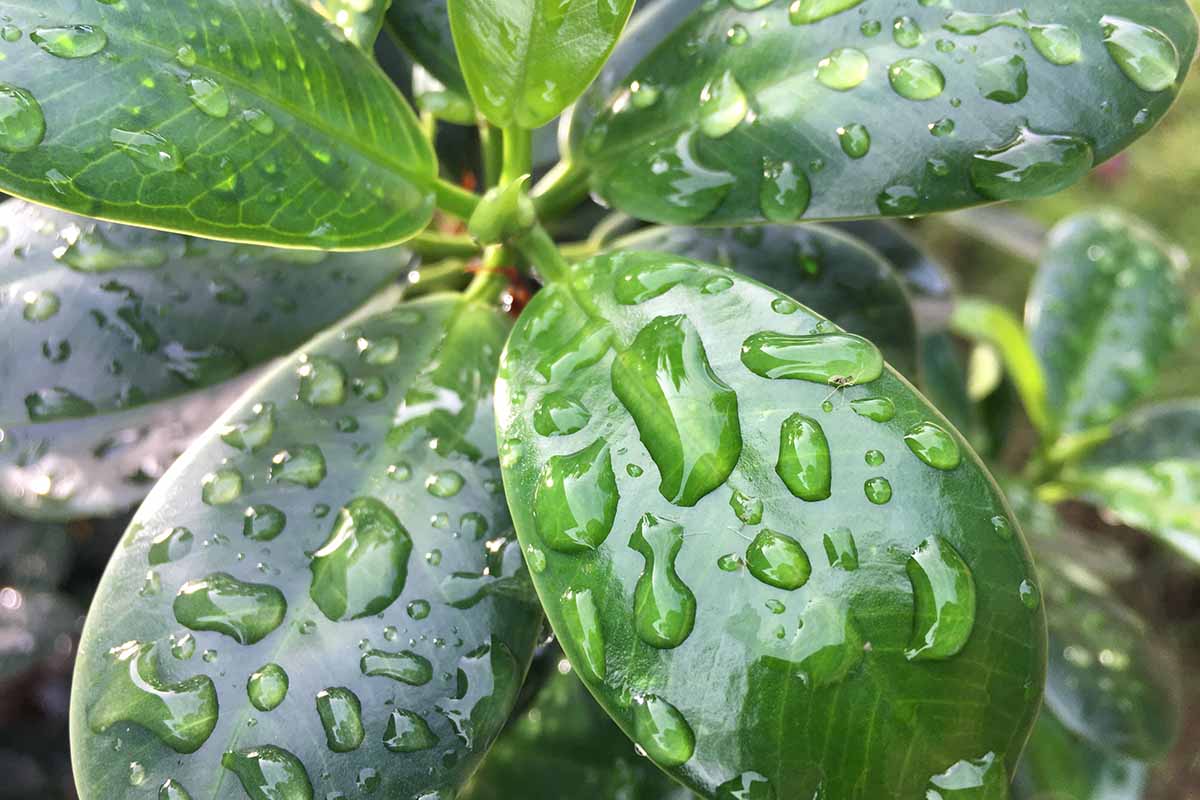
‘Moclame’ can grow up to ten feet tall and six feet wide but only if you provide it with an extremely large container. Otherwise, it stays about half that size.
Mini Flat Leaf
If you have bonsai dreams, find this cultivar. It’s a compact dwarf cultivar with smaller leaves than the species.
At under a foot tall, it takes on a cascading habit that looks incredible in a container.
Managing Pests and Disease
If you hate how readily F. benjamina drops its leaves, then F. microcarpa is a good alternative.
It holds its foliage better, even when a pest or disease strikes. Of course, as we mentioned, all Ficus species react to change or stress by dropping foliage, so if you notice that happening, or if you see the leaves changing color, it’s time to consider a pest or disease problem.
Let’s talk about the creepy crawlies, first:
Pests
There are just two insects that frequent ginseng ficus. Well, I should say that they aren’t frequently found on this houseplant, but if a pest is going to attack, it will likely be one of these:
Mealybugs
Mealybugs are little sap-suckers in the Pseudococcidae family. They’re incredibly common on plants and appear across the globe. They’re especially common on houseplants because they like the warmth and humidity often provided in an indoor growing environment.
They like to hang out on the undersides of leaves or on stems near leaf nodes and they leave behind a sticky sap known as honeydew. When present, you’ll see oval insects covered in a gray, peach, white, or cream-colored, waxy coating.
When they’re around, they reduce a plant’s vigor and can cause yellowing or dropping leaves.
They can also spread viral diseases.
If you notice these pests, early treatment makes it easier to eliminate them. Typically, treatment involves scraping them off, wiping them with isopropyl alcohol, or using an insecticide. We go over all the options in our guide.
Spider Mites
Spider mites are relatives of ticks in the family Tetranychidae and are another common household pest. They prefer dry conditions and cause similar damage to mealybugs.
You can tell the difference, though, because you might see tiny little red bugs scurrying across the stems and leaves, and you’ll probably see fine webbing on your plant.
Like mealybugs, they are sapsuckers that feed on the leaves and stems of the plant.
To deal with them, visit our guide for tips on spraying your plants, whether you opt to use water or an insecticide.
Disease
There’s really only one disease to watch for and it’s fairly easy to avoid if you are careful about watering and use an appropriate-sized pot with good drainage. Let’s talk rot:
Root Rot
Root rot can be either a disease caused by moisture-loving pathogens (Pythium and Fusarium spp.) or a physiological condition as a result of depriving the roots of oxygen by drowning them in too much water.
Either way, the roots will be in more moisture than is ideal and the leaves will start to turn pale or yellow and drop from the tree.
The solution is to check the drainage and make sure its open and flowing. If you have a catchment pot, make sure you empty it within 30 minutes after watering. Then, make sure you reduce the amount of water you’re giving.
To be extra sure your plant survives, remove it from the existing container, brush away all the soil, spray the roots with copper fungicide, and wipe out the container with a ten percent mix of bleach and water.
Replant with fresh, clean potting mix.
Best Uses for Ginseng Ficus
There’s a reason this plant works so well as a bonsai. It’s perfectly happy constrained in a container and takes on an aged appearance even when it’s young.
When grown as a bonsai, it’s one of the few trees that can stay indoors full time and will tolerate a wide range of light conditions.
We have a guide to help you grow them as bonsai here.
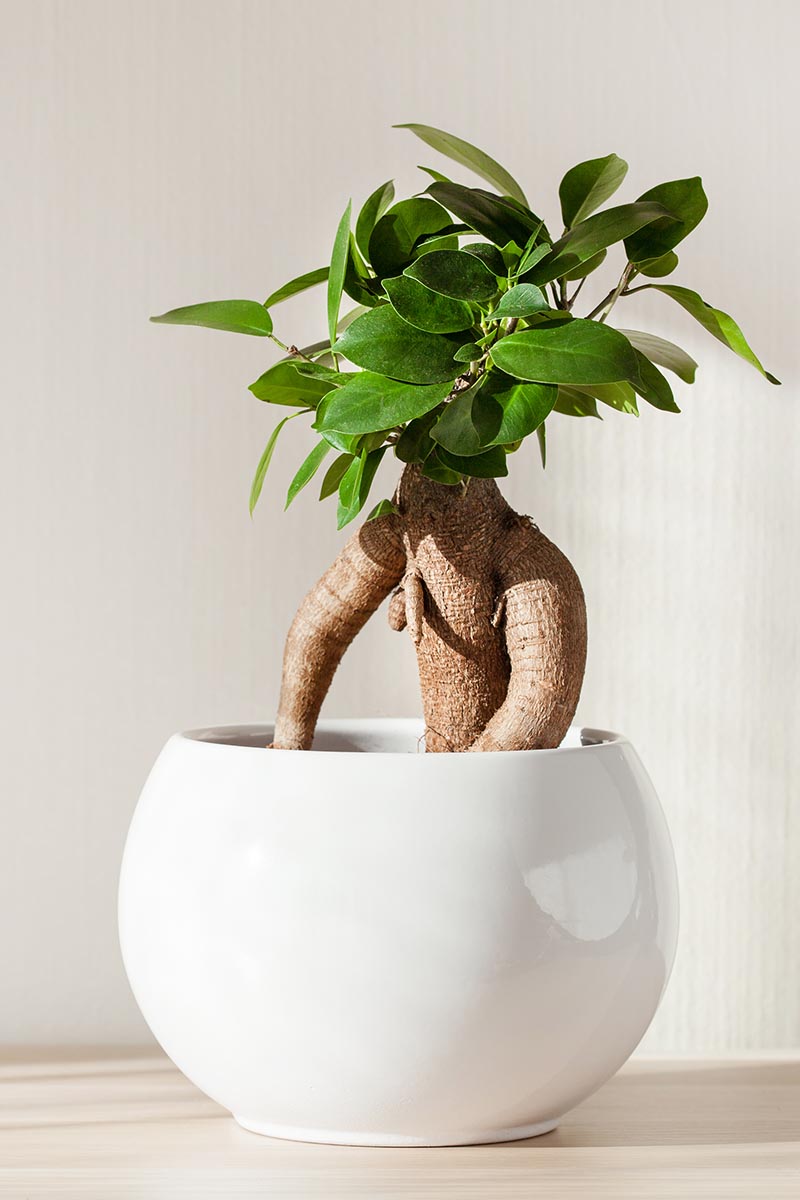
They also do well in conventional containers as a single specimen. You can train them into unusual shapes or topiary, or let them grow naturally.
Quick Reference Growing Guide
| Plant Type: | Evergreen epiphyte | Foliage Color: | Green, cream, yellow, white |
| Native to: | Asia, Australia, Himalayas, India, Japan, Nepal | Maintenance: | Low |
| Hardiness (USDA Zones): | 9-11 | Tolerance: | Some drought |
| Season: | Year-round | Soil Type: | Light, airy |
| Exposure: | Several hours of direct morning sun (indoors) | Soil pH: | 6.0-7.0 |
| Time to Maturity: | Over 10 years | Soil Drainage: | Well-draining |
| Planting Depth: | Same depth as container | Uses: | Bonsai, houseplant, potted specimen |
| Height: | 7 feet (indoors) over 50 feet (outdoors) | Order: | Rosales |
| Spread: | 4 feet (indoors) over 50 feet (outdoors) | Family: | Moraceae |
| Growth Rate: | Moderate | Genus: | Ficus |
| Water Needs: | Moderate | Subgenus: | Urostigma |
| Common Pests and Diseases: | Mealybugs, spider mites; Root rot | Species: | Microcarpa |
Ginseng Figs Are Fabulous Ficus Houseplants
If Benjamin figs are too fickle and fiddle-leaf figs are too finicky, you’re going to love ginseng ficus. They’re adaptable and elegant, demanding little more than some water and a good pot to grow in.
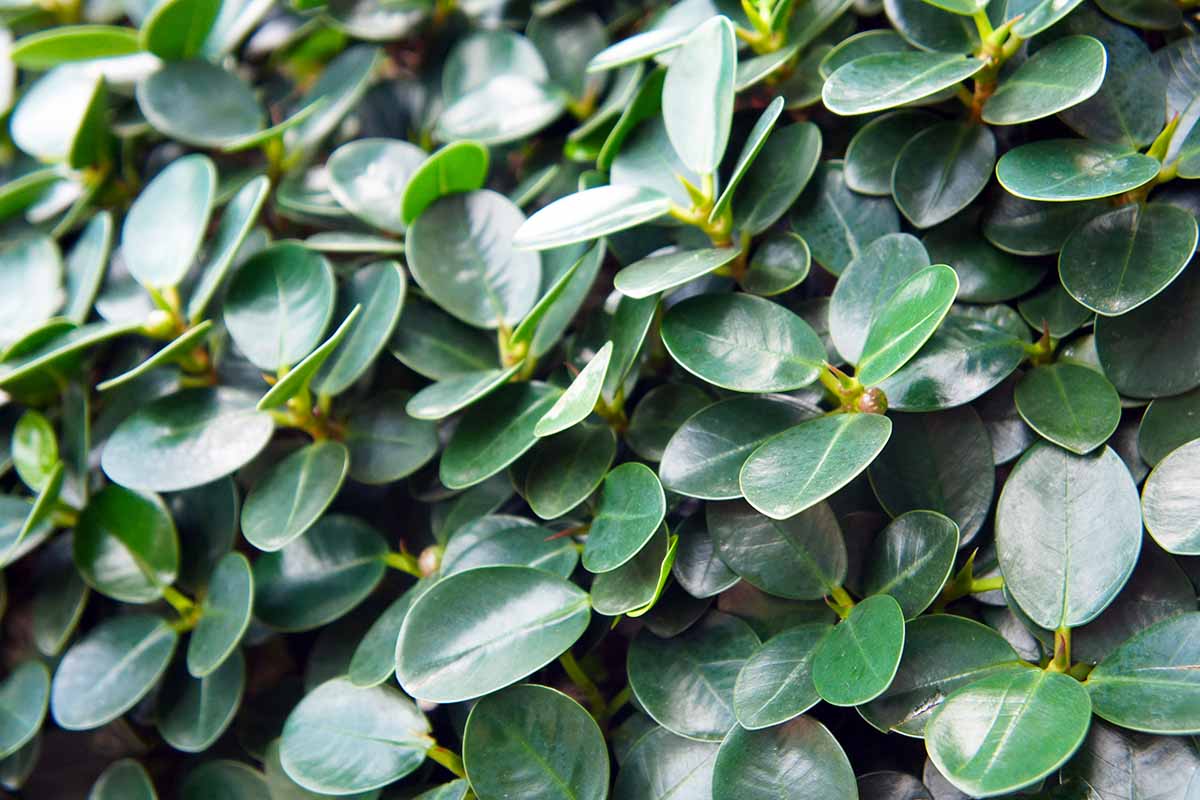
Which cultivar is calling your name? How do you plan to grow it? Are you going to train it into bonsai? Grow it as a small indoor tree? Let us know in the comments section below.
Was this guide helpful in your growing journey? If you’d like to learn more about the fascinating plants in the ficus genus, we have a few other guides that you might find useful. Consider giving these a look next:

